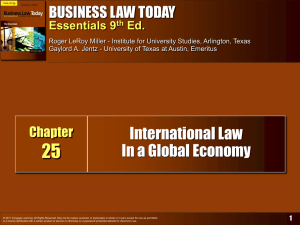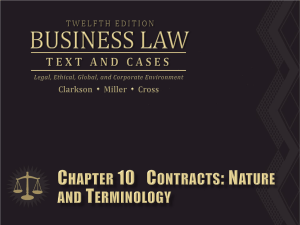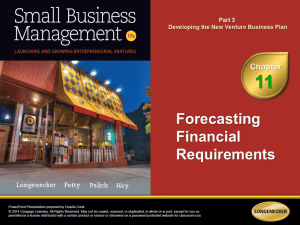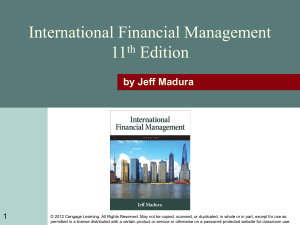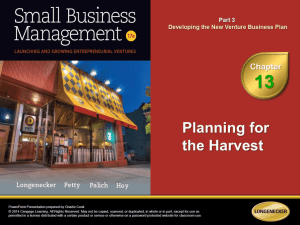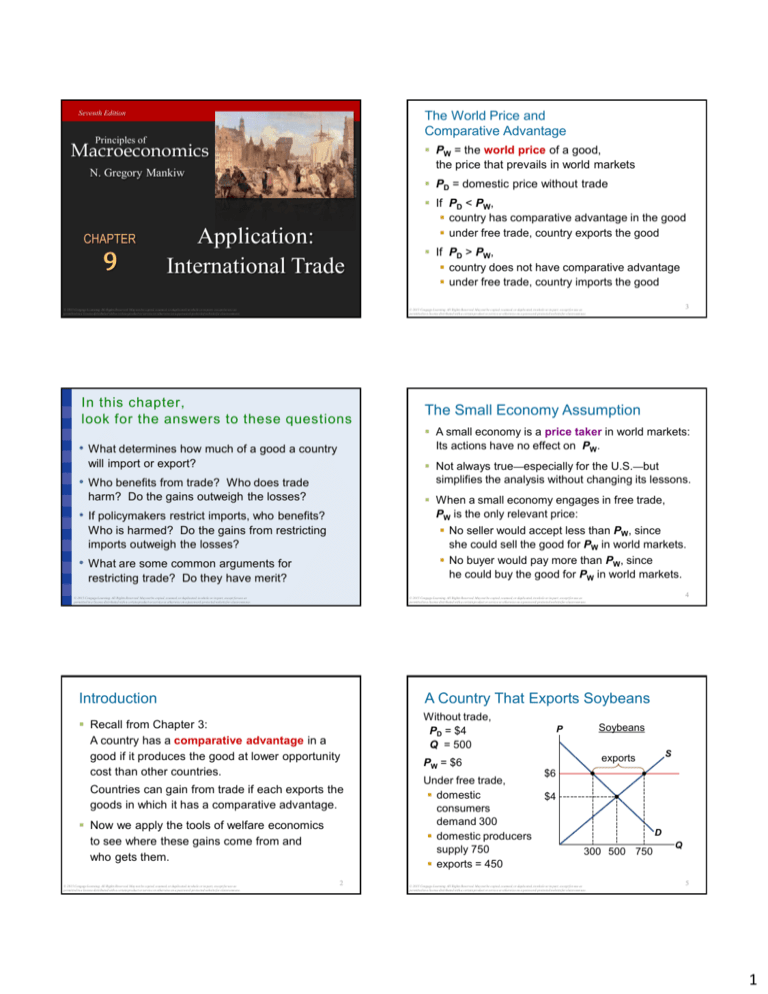
Seventh Edition
The World Price and
Comparative Advantage
Principles of
Wojciech Gerson (1831-1901)
Macroeconomics
N. Gregory Mankiw
CHAPTER
9
Application:
International Trade
© 2015 Cengage Learning. All Rights Reserved. May not be copied, scanned, or duplicated, in whole or in part, except for use as
permitted in a license distributed with a certain product or service or otherwise on a password-protected website for classroom use.
PD = domestic price without trade
If PD < PW,
country has comparative advantage in the good
under free trade, country exports the good
If PD > PW,
country does not have comparative advantage
under free trade, country imports the good
3
© 2015 Cengage Learning. All Rights Reserved. May not be copied, scanned, or duplicated, in whole or in part, except for use as
permitted in a license distributed with a certain product or service or otherwise on a password-protected website for classroom use.
In this chapter,
look for the answers to these questions
• What determines how much of a good a country
will import or export?
The Small Economy Assumption
A small economy is a price taker in world markets:
Its actions have no effect on PW.
Not always true—especially for the U.S.—but
simplifies the analysis without changing its lessons.
• Who benefits from trade? Who does trade
harm? Do the gains outweigh the losses?
When a small economy engages in free trade,
PW is the only relevant price:
No seller would accept less than PW, since
she could sell the good for PW in world markets.
• If policymakers restrict imports, who benefits?
Who is harmed? Do the gains from restricting
imports outweigh the losses?
No buyer would pay more than PW, since
he could buy the good for PW in world markets.
• What are some common arguments for
restricting trade? Do they have merit?
© 2015 Cengage Learning. All Rights Reserved. May not be copied, scanned, or duplicated, in whole or in part, except for use as
permitted in a license distributed with a certain product or service or otherwise on a password-protected website for classroom use.
4
© 2015 Cengage Learning. All Rights Reserved. May not be copied, scanned, or duplicated, in whole or in part, except for use as
permitted in a license distributed with a certain product or service or otherwise on a password-protected website for classroom use.
Introduction
A Country That Exports Soybeans
Recall from Chapter 3:
A country has a comparative advantage in a
good if it produces the good at lower opportunity
cost than other countries.
Countries can gain from trade if each exports the
goods in which it has a comparative advantage.
Now we apply the tools of welfare economics
to see where these gains come from and
who gets them.
© 2015 Cengage Learning. All Rights Reserved. May not be copied, scanned, or duplicated, in whole or in part, except for use as
permitted in a license distributed with a certain product or service or otherwise on a password-protected website for classroom use.
PW = the world price of a good,
the price that prevails in world markets
2
Without trade,
PD = $4
Q = 500
PW = $6
Under free trade,
domestic
consumers
demand 300
domestic producers
supply 750
exports = 450
Soybeans
P
S
exports
$6
$4
D
300 500 750
© 2015 Cengage Learning. All Rights Reserved. May not be copied, scanned, or duplicated, in whole or in part, except for use as
permitted in a license distributed with a certain product or service or otherwise on a password-protected website for classroom use.
Q
5
1
ACTIVE LEARNING
A Country That Exports Soybeans
Without trade,
CS = A + B
PS = C
Total surplus
=A+B+C
Soybeans
P
Without trade,
CS = A
PS = B + C
Total surplus
=A+B+C
S
exports
A
$6
D
B
With trade,
CS = A
PS = B + C + D
Total surplus
=A+B+C +D
$4
D
Q
6
© 2015 Cengage Learning. All Rights Reserved. May not be copied, scanned, or duplicated, in whole or in part, except for use as
permitted in a license distributed with a certain product or service or otherwise on a password-protected website for classroom use.
ACTIVE LEARNING
1
P
gains
from trade
A
D
imports
D
Q
PD < PW
PD > PW
exports
imports
consumer surplus
falls
rises
producer surplus
rises
falls
total surplus
rises
rises
direction of trade
S
$3000
$1500
D
Identify CS, PS, and
total surplus without
trade, and with trade.
200
400
Q
600
© 2015 Cengage Learning. All Rights Reserved. May not be copied, scanned, or duplicated, in whole or in part, except for use as
permitted in a license distributed with a certain product or service or otherwise on a password-protected website for classroom use.
ACTIVE LEARNING
Whether a good is imported or exported,
trade creates winners and losers.
But the gains exceed the losses.
© 2015 Cengage Learning. All Rights Reserved. May not be copied, scanned, or duplicated, in whole or in part, except for use as
permitted in a license distributed with a certain product or service or otherwise on a password-protected website for classroom use.
1
10
Other Benefits of International Trade
Answers
Under free trade,
domestic
consumers
demand 600
domestic
producers
supply 200
imports = 400
S
© 2015 Cengage Learning. All Rights Reserved. May not be copied, scanned, or duplicated, in whole or in part, except for use as
permitted in a license distributed with a certain product or service or otherwise on a password-protected website for classroom use.
Plasma TVs
In world markets,
PW = $1500
Under free trade,
how many TVs
will the country
import or export?
Plasma TVs
Summary: The Welfare Effects of Trade
Analysis of trade
Without trade,
PD = $3000, Q = 400
P
$3000
With trade,
B
CS = A + B + D
$1500
C
PS = C
Total surplus
=A+B+C +D
gains
from trade
C
1
Answers
P
Consumers enjoy increased variety of goods.
Plasma TVs
Producers sell to a larger market, may achieve
lower costs by producing on a larger scale.
S
Competition from abroad may reduce market
power of domestic firms, which would increase
total welfare.
$3000
$1500
D
imports
200
© 2015 Cengage Learning. All Rights Reserved. May not be copied, scanned, or duplicated, in whole or in part, except for use as
permitted in a license distributed with a certain product or service or otherwise on a password-protected website for classroom use.
600
Q
Trade enhances the flow of ideas, facilitates the
spread of technology around the world.
© 2015 Cengage Learning. All Rights Reserved. May not be copied, scanned, or duplicated, in whole or in part, except for use as
permitted in a license distributed with a certain product or service or otherwise on a password-protected website for classroom use.
11
2
Analysis of a Tariff on Cotton Shirts
Then Why All the Opposition to Trade?
Recall one of the Ten Principles from Chapter 1:
Trade can make everyone better off.
The winners from trade could compensate the losers
and still be better off.
Yet, such compensation rarely occurs.
The losses are often highly concentrated among
a small group of people, who feel them acutely.
The gains are often spread thinly over many people,
who may not see how trade benefits them.
Hence, the losers have more incentive to organize
and lobby for restrictions on trade.
12
© 2015 Cengage Learning. All Rights Reserved. May not be copied, scanned, or duplicated, in whole or in part, except for use as
permitted in a license distributed with a certain product or service or otherwise on a password-protected website for classroom use.
Tariff: An Example of a Trade Restriction
Tariff: a tax on imports
Example: Cotton shirts
PW = $20
Tariff: T = $10/shirt
Consumers must pay $30 for an imported shirt.
So, domestic producers can charge $30 per shirt.
In general, the price facing domestic buyers &
sellers equals (PW + T ).
P
Free trade
CS = A + B + C
+D+E+F
PS = G
Total surplus = A + B
+C+D+E+F+G
Tariff
CS = A + B
PS = C + G
Revenue = E
Total surplus = A + B
+C+E+G
Cotton
shirts
deadweight
loss = D + F
S
A
B
$30
C
$20
D
P
Cotton shirts
Free trade:
buyers demand 80
sellers supply 25
imports = 55
T = $10/shirt
price rises to $30
buyers demand 70
sellers supply 40
imports = 30
$20
imports
imports
© 2015 Cengage Learning. All Rights Reserved. May not be copied, scanned, or duplicated, in whole or in part, except for use as
permitted in a license distributed with a certain product or service or otherwise on a password-protected website for classroom use.
15
Analysis of a Tariff on Cotton Shirts
P
D = deadweight loss
from the
overproduction
of shirts
F = deadweight loss
from the underconsumption
of shirts
Cotton
shirts
deadweight
loss = D + F
S
A
B
$30
C
D
E
F
G
40
70 80
© 2015 Cengage Learning. All Rights Reserved. May not be copied, scanned, or duplicated, in whole or in part, except for use as
permitted in a license distributed with a certain product or service or otherwise on a password-protected website for classroom use.
D
Q
16
Mostly has the same effects as a tariff:
Raises price, reduces quantity of imports.
Reduces buyers’ welfare.
Increases sellers’ welfare.
$30
40
D
Q
Import quota: a quantitative limit on imports of a
good.
S
25
70 80
Import Quotas:
Another Way to Restrict Trade
Analysis of a Tariff on Cotton Shirts
PW = $20
40
© 2015 Cengage Learning. All Rights Reserved. May not be copied, scanned, or duplicated, in whole or in part, except for use as
permitted in a license distributed with a certain product or service or otherwise on a password-protected website for classroom use.
25
13
F
G
25
$20
© 2015 Cengage Learning. All Rights Reserved. May not be copied, scanned, or duplicated, in whole or in part, except for use as
permitted in a license distributed with a certain product or service or otherwise on a password-protected website for classroom use.
E
70 80
D
Q
14
A tariff creates revenue for the govt. A quota
creates profits for the foreign producers of the
imported goods, who can sell them at higher price.
Or, govt could auction licenses to import to capture
this profit as revenue. Usually it does not.
© 2015 Cengage Learning. All Rights Reserved. May not be copied, scanned, or duplicated, in whole or in part, except for use as
permitted in a license distributed with a certain product or service or otherwise on a password-protected website for classroom use.
17
3
Arguments for Restricting Trade
Arguments for Restricting Trade
1. The jobs argument
3. The infant-industry argument
A new industry argues for temporary protection
until it is mature and can compete with foreign
firms.
Trade destroys jobs in industries that compete
with imports.
Economists’ response:
Total unemployment does not rise as imports rise,
because job losses from imports are offset by
job gains in export industries….
18
© 2015 Cengage Learning. All Rights Reserved. May not be copied, scanned, or duplicated, in whole or in part, except for use as
permitted in a license distributed with a certain product or service or otherwise on a password-protected website for classroom use.
U.S. Imports & Unemployment,
12%
10%
8%
Unemployment
(% of labor force)
4%
20012010
19912000
19811990
19711980
2%
19611970
21
4. The unfair-competition argument
Producers argue their competitors in another
country have an unfair advantage,
e.g. due to govt subsidies.
Imports
(% of GDP)
14%
0%
© 2015 Cengage Learning. All Rights Reserved. May not be copied, scanned, or duplicated, in whole or in part, except for use as
permitted in a license distributed with a certain product or service or otherwise on a password-protected website for classroom use.
Arguments for Restricting Trade
Decade averages, 1961–2010
16%
6%
Economists’ response:
Difficult for govt to determine which industries
will eventually be able to compete and whether
benefits of establishing these industries exceed
cost to consumers of restricting imports.
Besides, if a firm will be profitable in the long run,
it should be willing to incur temporary losses.
Economists’ response:
We should welcome imports of low-cost products
subsidized by the other country’s taxpayers.
The gains to our consumers will exceed the
losses to our producers.
© 2015 Cengage Learning. All Rights Reserved. May not be copied, scanned, or duplicated, in whole or in part, except for use as
permitted in a license distributed with a certain product or service or otherwise on a password-protected website for classroom use.
22
Arguments for Restricting Trade
Arguments for Restricting Trade
2. The national security argument
An industry vital to national security should be
protected from foreign competition, to prevent
dependence on imports that could be disrupted
during wartime.
5. The protection-as-bargaining-chip argument
Example: The U.S. can threaten to limit imports
of French wine unless France lifts their quotas
on American beef.
Economists’ response:
Suppose France refuses. Then the U.S. must
choose between two bad options:
Economists’ response:
Fine, if trade restrictions based on true security
needs.
But producers may exaggerate their own
importance to national security to obtain
protection from foreign competition.
© 2015 Cengage Learning. All Rights Reserved. May not be copied, scanned, or duplicated, in whole or in part, except for use as
permitted in a license distributed with a certain product or service or otherwise on a password-protected website for classroom use.
A) Restrict imports from France, which reduces
welfare in the U.S.
B) Don’t restrict imports, which reduces U.S.
credibility.
20
© 2015 Cengage Learning. All Rights Reserved. May not be copied, scanned, or duplicated, in whole or in part, except for use as
permitted in a license distributed with a certain product or service or otherwise on a password-protected website for classroom use.
23
4
Trade Agreements
A country can liberalize trade with
unilateral reductions in trade restrictions
multilateral agreements with other nations
Examples of trade agreements:
North American Free Trade Agreement
(NAFTA), 1993
General Agreement on Tariffs and Trade
(GATT), ongoing
World Trade Organization (WTO), est. 1995,
enforces trade agreements, resolves disputes
© 2015 Cengage Learning. All Rights Reserved. May not be copied, scanned, or duplicated, in whole or in part, except for use as
permitted in a license distributed with a certain product or service or otherwise on a password-protected website for classroom use.
24
Summary
• A country will export a good if the world price of
the good is higher than the domestic price without
trade. Trade raises producer surplus, reduces
consumer surplus, and raises total surplus.
• A country will import a good if the world price
is lower than the domestic price without trade.
Trade lowers producer surplus but raises
consumer and total surplus.
• A tariff benefits producers and generates revenue
for the govt, but the losses to consumers exceed
these gains.
© 2015 Cengage Learning. All Rights Reserved. May not be copied, scanned, or duplicated, in whole or in part, except for use as
permitted in a license distributed with a certain product or service or otherwise on a password-protected website for classroom use.
Summary
• Common arguments for restricting trade include:
protecting jobs, defending national security,
helping infant industries, preventing unfair
competition, and responding to foreign trade
restrictions.
• Some of these arguments have merit in some
cases, but economists believe free trade is
usually the better policy.
© 2015 Cengage Learning. All Rights Reserved. May not be copied, scanned, or duplicated, in whole or in part, except for use as
permitted in a license distributed with a certain product or service or otherwise on a password-protected website for classroom use.
5



